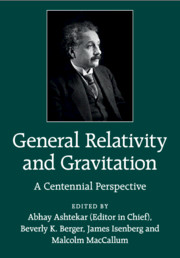Book contents
- Frontmatter
- Contents
- Preface
- List of contributors
- List of figures
- List of tables
- Part One Einstein's Triumph
- 1 100 Years of General Relativity
- 2 Was Einstein Right? A Centenary Assessment
- 3 Relativistic Astrophysics
- 4 Cosmology
- Part Two New Window on the Universe: Gravitational Waves
- Part Three Gravity is Geometry, after all
- Part Four Beyond Einstein
- Index
- References
1 - 100 Years of General Relativity
from Part One - Einstein's Triumph
Published online by Cambridge University Press: 05 June 2015
- Frontmatter
- Contents
- Preface
- List of contributors
- List of figures
- List of tables
- Part One Einstein's Triumph
- 1 100 Years of General Relativity
- 2 Was Einstein Right? A Centenary Assessment
- 3 Relativistic Astrophysics
- 4 Cosmology
- Part Two New Window on the Universe: Gravitational Waves
- Part Three Gravity is Geometry, after all
- Part Four Beyond Einstein
- Index
- References
Summary
This chapter aims to provide a broad historical overview of the major developments in General Relativity Theory (‘GR’) after the theory had been developed in its final form. It will not relate the well-documented story of the discovery of the theory by Albert Einstein, but rather will consider the spectacular growth of the subject as it developed into a mainstream branch of physics, high-energy astrophysics, and cosmology. Literally hundreds of exact solutions of the full non-linear field equations are now known, despite their complexity [1]. The most important ones are the Schwarzschild and Kerr solutions, determining the geometry of the solar system and of black holes (Section 1.2), and the Friedmann–Lemaître– Robertson–Walker solutions, which are basic to cosmology (Section 1.4). Perturbations of these solutions make them the key to astrophysical applications.
Rather than tracing a historical story, this chapter is structured in terms of key themes in the study and application of GR:
The study of dynamic geometry (Section 1.1) through development of various technical tools, in particular the introduction of global methods, resulting in global existence and uniqueness theorems and singularity theorems.
The study of the vacuum Schwarzschild solution and its application to the Solar system (Section 1.2), giving very accurate tests of general relativity, and underlying the crucial role of GR in the accuracy of useful GPS systems.
The understanding of gravitational collapse and the nature of Black Holes (Section 1.3), with major applications in astrophysics, in particular as regards quasi-stellar objects and active galactic nuclei.
The development of cosmological models (Section 1.4), providing the basis for our understandings of both the origin and evolution of the universe as a whole, and of structure formation within it.
The study of gravitational lensing and its astronomical applications, including detection of dark matter (Section 1.5).
Theoretical studies of gravitational waves, in particular resulting in major developments in numerical relativity (Section 1.6), and with development of gravitational wave observatories that have the potential to become an essential tool in precision cosmology.
- Type
- Chapter
- Information
- General Relativity and GravitationA Centennial Perspective, pp. 10 - 48Publisher: Cambridge University PressPrint publication year: 2015
References
- 1
- Cited by



